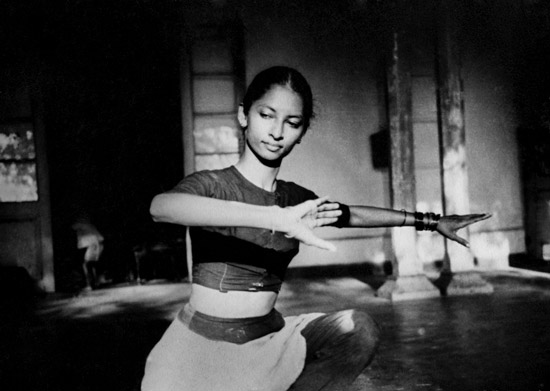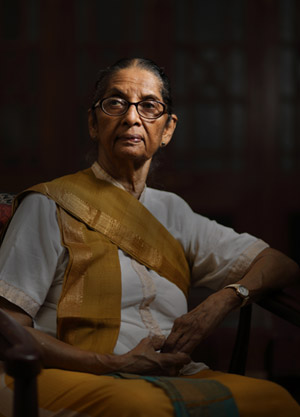‘From a drop to an ocean’: Vajira’s contribution to Kandyan Dance
Writing about Chitrasena, I realised, was impossible without accounting for her contribution. Reading accounts of Vajira, particularly in newspaper articles, I found her life work often reduced to a series of headlines and superlatives, and it was only a couple of rare authors that reflected on her multifaceted contribution. With her passing it becomes even more important to acknowledge the role she played in the development of traditional dance on stage.

Vajira in a Kandyan dance solo with master drummers K.N.S. Atugoda and Siri Ahugoda - Photo by Nihal Fernando
Vajira is frequently referred to as the first female Kandyan dancer. This simple phrasing is both inaccurate and fails to capture her full contribution to traditional dance. She was not the first woman to stage Kandyan dance as she was preceded by a handful of female dancers who performed regularly, albeit for a brief period, in Colombo theatres. They were not only pioneers in terms of breaking new ground for women but for the form itself. During the 1930s Kandyan dance was largely ritualistic, ceremonial and rural, and they along with their male colleagues, both from the traditional practitioners/gurunnanses and their modern counterparts, the stage dancers played a crucial role in making it part of theatre entertainment.
However, Vajira was probably the first female professional dancer who made dance her vocation. Born on March 15, 1932, Vajira took to dance reluctantly, forced by her mother to attend classes conducted at their home by an emerging young dancer, Chitrasena. “They were all probably in love with him,” she recalled describing her fellow students of teenage girls and adult women. Vajira would go on to attend dance classes at different institutions and finally end up as a resident student at Chitrasena’s dance school, the Kalayathanaya, which he set up in 1943 at his home in Colpetty.

The graceful young dancer who captured the hearts of audiences. Photo courtesy CVDF Archives
She became a member of his troupe as Chitrasena along with leading dancers from that period sought to create a space for dance in theatres and a loyal audience who would be willing to return to watch dance. It is misleading to assume that Kandyan dance had an automatic slot on stage, as Chitrasena and his fellow pioneers had to battle the prejudices of both Kandyan elites and traditional practitioners who thought of theatre as an unsuitable space, and anglicised urban elites who looked down on local art forms. Besides presenting traditional dance items, largely Kandyan and later Low Country, Chitrasena began crafting short ballets or mudra natya. To this day Chitrasena’s creations such as Karadiya, Nala Damayanthi and Kinkini Kolama are seen as the archetypes of mudra natya, with Vajira as the female lead in the first two.
In 1948 as Sri Lanka celebrated its independence with a massive cultural event, the Pageant of Lanka, Vajira marked her debut. Different cultural troupes were given scenes depicting key events in the island’s history. Chitrasena’s troupe performed a portion of the Ramayana, with Vajira playing the role of the demon in the apparition of a deer. “She captured the hearts of everyone and was the talking point of all the men in the audience,” remarked Ena de Silva, who was a fellow participant and went on to become one the island’s most famous batik artists. Vajira would go on to perform for over 50 years in theatres in different urban centres across Sri Lanka and on the global stage, including in Moscow, London, Sydney and New Delhi.
The embodiment of Lasya

Vajira the legend: Portrait by Luxshman Nadaraja
Vajira would come to be seen as the ‘prima ballerina of Kandyan dance” and the epitome of the female form of the dance. In general, Kandyan is considered to be a masculine or tandava dance not merely because its traditional practitioners were male but in terms of its energy and movement style. With the advent of the female dancer on stage it is claimed that Kandyan dance developed a lasya or feminine form. Reviews of Vajira often emphasized her grace, essentializing the feminine quality of her dance. To see her in this light is to fail to grasp what she brought to the dance.
The transformation of Gajaga Vannama as performed by the Chitrasena Ensemble demonstrated the potential for the female dancer. Traditionally this piece depicts through song and dance a mythical and majestic elephant living in the heavens. In the 1960s Vajira adapted the vannama to create an all-female ensemble piece featuring a soloist. Bandula Jayawardene, a reviewer of the time, praised the piece: “…there is her transformation or rather transmutation of the originally masculine Gajaga Vannama into a thing of unrivalled feminine grace without losing anything of the beauty of this treasure of the traditional Kandyan dancing.” Looking at the video of the piece being shared across facebook over the last few days it is impossible not to see the weight and power beyond the grace of a 60-year-old Vajira.
She did not seek to limit her female dancer but attempted to push the boundaries of traditional dance. In the Kandyan duet with Chitrasena, Vajira not only sought to match her partner’s leaps. “She was always challenging him, even in her jumps,” recalls Upeka, their daughter and celebrated dancer. The power of her dance inspired the next generation of female dancers such as Upeka and Khema who, especially in their Low Country items, present raw energy, vigour and control. For young female dancers she also served as an example of how it was possible to take up dance as a vocation, including of continuing to dance while being a mother. That she went on tour to Soviet Union in 1957 barely three months after delivering her third child is nothing short of astounding.
The multi-faceted artist
Vajira the dancer has been described as Chitrasena’s greatest creation. She was, however more than just a dancer even to Chitrasena. She played many roles including but not limited to dance partner, spouse, mother of their three children, lead teacher of the Kalayathanaya, and co-choreographer. Throughout her life Vajira would insist that Chitrasena was her guru. He was not just her teacher from whom she not only learned dance but imbibed multiple skill sets that were required to create and stage productions. She would become his co-creator.
Looking at the contemporary dance world, male choreographers continue to dominate in the northern hemisphere, while South Asia, by contrast, continues to produce prominent women choreographers. In Sri Lanka Vajira played a pivotal role in marking out an expansive role that women could play in traditional dance. Her experimentation with choreography began quite early, starting with children’s ballets. She would produce up to 11 such productions where she would develop the plot and the movements, providing a platform for children from different age groups to participate. Chitrasena gave her freedom to re-work her own sequences such as the swan scene from Nala Damayanthi. It is possible that this sequence inspired him to transform the short mudra natya (1949) into a fully-fledged ballet (1961). From the 1980s she took the lead to develop the mudra natya Shiva Ranga, as she was tired of waiting for him to be inspired, as she wanted to feature the young emerging stars – Ravibandu, Upeka and Channa.
The troupe’s traditional repertoire expanded with Vajira’s emergence as the choreographer. She worked with a range of traditional artists, initially helping some of them finetune items for stage, working on orientation and symmetry, while Chitrasena selected the sequences from the ritual dance suitable for the stage. It was she who re-choreographed the Gajaga Vannama, adding arm gestures to depict the movement of the elephant’s trunk and ears, that was then re-presented by other artists. Through her remarkable collaborations with Piyasara Silpathipathi for Kandyan and J.D. Gunatunga for Low Country, they not only crafted innovative dance and drum pieces, but also demonstrated that the traditional repertoire could be expanded, or to use Chitrasena’s own words where “the new is just an extension of the old.”
It would not be an exaggeration to say that she dramatically transformed the teaching of Kandyan dancing, which traditionally was taught through example by gurunnanses demonstrating and their students repeating the steps behind them. Vajira sought to break down the movements into a series of exercises so that students could learn stances, hand and leg positions, and isolate jumps and turns. These would serve as building blocks to create movement sequences. This approach made it easier for her to set choreography for the ballets and teaching became more effective and precise, also making it easier for the students to develop strong technique.
This focus on precision and lines created a Chitrasena Style. The inspiration for developing this pedagogy may lie in her visits to ballet schools during their tours in Europe. Chitrasena described her “like a sponge” always open to learning and absorbing new influences, which she would carefully and selectively adapt in her practice.
There are many aspects to Vajira’s personality that proved essential in her efforts to create new work and sustain the school and ensemble, despite many obstacles, especially the devastating loss of the Colpetty property in 1982, but the trait that I would highlight is relentless. Forced to be a nomad for 25 years from the 1980s to the early 2000s Vajira continued to teach and stage productions, holding classes and rehearsals in multiple locations. As a 60-year-old she would drive herself and unpack and re-pack the drum, costume trunks and sets. Even fracturing her hip at the age of 87, did not stop her from teaching herself to walk again, but also creating a set of exercises for those who are bedridden to follow. Up until the COVID pandemic Vajira continued teaching and would watch rehearsals with a keen eye.
But she was also relentless in her passion for the dance; like her unquenched desire to keep pushing the boundaries of her art form be it through teaching or creating new items. Lapaya Gurunnanse, Chitrasena’s and her teacher told her, “mama wathura bhinduwak dunnahama, eka nona maha muhudak kara (I gave you a drop of water and you made an ocean of it). And it is this same passion that she has passed on to the next generation of women at the Kalayathanaya and their male counterparts as they continue to expand her pedagogy and explore the rich source material found in the ritual dance.
(Mirak Raheem is a researcher and activist, and former Commissioner of the Office on Missing Persons)
Searching for an ideal partner? Find your soul mate on Hitad.lk, Sri Lanka's favourite marriage proposals page. With Hitad.lk matrimonial advertisements you have access to thousands of ads from potential suitors who are looking for someone just like you.


